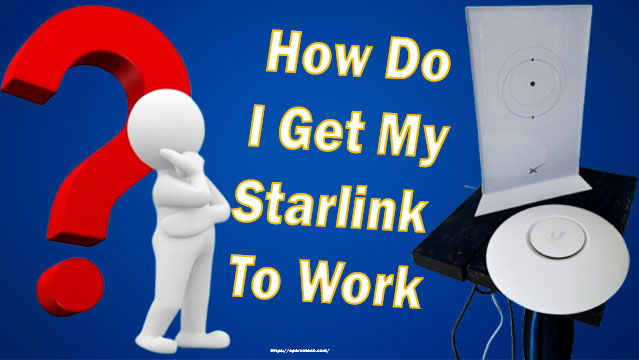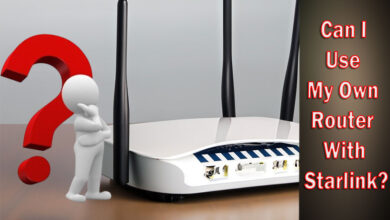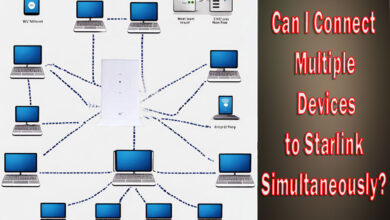How Do I Get My Starlink To Work

To get your Starlink to work, ensure that you have a clear view of the sky and follow the installation instructions provided. Are you struggling to get your Starlink satellite internet connection up and running?
Look no further! We will provide you with the exact steps you need to take to get your Starlink to work smoothly and efficiently. Starlink is a satellite internet service provided by SpaceX, offering high-speed internet access to even remote and rural areas.
However, setting up your Starlink can sometimes be a bit tricky. But don’t worry, by following a few simple steps and ensuring you meet the requirements, you’ll be online in no time. So let’s dive in and get your Starlink connection up and running!
What Is Starlink And How Does It Work
Starlink is a satellite internet constellation developed by SpaceX. With a dish connected to a user’s location, it receives signals from the satellites, providing internet access in remote areas where traditional infrastructure is not available.
Overview Of Starlink Internet Service
Starlink is a revolutionary internet service that aims to provide fast and reliable internet access to rural and remote areas around the world. It utilizes a constellation of small satellites that are placed in low Earth orbit, forming a network that delivers internet connectivity to users on the ground.
By bypassing traditional infrastructure constraints, Starlink offers an innovative solution to bridge the digital divide and offer high-speed internet where it was previously unavailable.
Explanation Of The Satellite Constellation System
The Starlink satellite constellation system consists of thousands of small satellites, which are launched into space and placed in low Earth orbit. These satellites work together in a synchronized manner to create a robust and interconnected network. By deploying a large number of satellites, Starlink ensures consistent coverage and minimizes latency issues that are typically associated with satellite internet services.
The satellites are positioned in such a way that they create a mesh-like network, constantly relaying signals to one another, creating a seamless connection. This system allows for efficient data transmission and ensures that users have uninterrupted access to the internet, regardless of their location.
How Starlink Connects To The Internet
Starlink uses a unique approach to connect users to the internet. Instead of relying on traditional ground-based infrastructure, such as fiber-optic cables, it connects directly to the satellites orbiting in space. Here’s how it works:
- User Terminal: Each user is provided with a user terminal, which serves as the gateway for internet connection. The terminal is a small, dish-like device that communicates with the Starlink satellites. It automatically tracks and connects to the nearest satellite, establishing a link between the user’s location and the Starlink network.
- Satellite Communication: When a user wants to access the internet, the user terminal sends signals to the nearest Starlink satellite. The satellite then relays the signals to other satellites in the network, creating an interconnected web. This network of satellites works together to transmit data between the user terminal and the ground stations on Earth.
- Ground Stations: Ground stations act as the interface between the satellite network and the global internet infrastructure. They receive the signals from the satellites and relay them to the internet backbone, which connects to the wider internet. Similarly, they receive incoming data from the internet and transmit it back to the user via the satellite network. This two-way communication ensures seamless connectivity and enables users to browse the internet, stream videos, and engage in online activities with low latency.
Starlink’s satellite constellation system enables users to connect to the internet by utilizing a network of small satellites in low Earth orbit. By connecting directly to the satellites, Starlink bypasses traditional infrastructure limitations, offering fast and reliable internet access to underserved areas.
Checking The Eligibility For Starlink
To ensure that your Starlink connection works smoothly, it is essential to check your eligibility. By following this step, you can determine if you have met the necessary requirements for Starlink to operate effectively.
If you’ve heard about Starlink and are eager to get your hands on the service, you may be wondering how to check if you’re eligible. Don’t worry, we’ve got you covered! In this section, we’ll discuss the requirements for Starlink service and go over the steps to determine if you’re eligible and how to check availability in your area.
Requirements For Starlink Service:
- Access to the Internet: Starlink requires an internet connection to function, so having an existing service provider is necessary.
- Location: Starlink is currently available in select areas. To be eligible, you need to reside in a region where Starlink is available. Keep in mind that coverage is expanding over time.
- Subscription: In order to use Starlink, you’ll need to subscribe to their service. More details regarding the pricing and subscription plans can be found on the official Starlink website.
How To Determine If You Are Eligible For Starlink:
Determining your eligibility for Starlink is a straightforward process. Here’s what you need to do:
- Check your location: Start by confirming if Starlink is available in your area. Check the official Starlink website or other reliable sources to find out.
- Check coverage: Even if Starlink is available in your broader region, make sure to check if your specific location is covered. Factors like obstructions or other limitations may impact coverage in certain areas.
- Consider your requirements: Assess your internet requirements and compare them to what Starlink offers. Keep in mind that Starlink is primarily designed for those who live in remote or rural areas with limited internet options.
Steps To Check The Availability Of Starlink In Your Area:
Now that you know the requirements and how to determine your eligibility, let’s go over the steps to check the availability of Starlink in your area:
- Visit the official Starlink website.
- Look for the “Check Availability” or similar options on their homepage.
- Enter your address or location details as prompted.
- The system will check if Starlink is available in your area and provide you with the necessary information.
- If Starlink is available, you can proceed with subscribing to their service according to the instructions provided.
Remember, Starlink availability may change over time, so it’s a good idea to periodically check for updates or sign up for notifications to stay informed.
With these simple steps, you’ll be able to determine if you’re eligible for Starlink and find out if the service is available in your area. Stay connected, wherever you are, with Starlink!
Equipment Required For Starlink Installation
The equipment required for Starlink installation includes a satellite dish, a mounting tripod, a power supply, and a router. To get your Starlink to work, you need to set up these components correctly and ensure a clear view of the sky for optimal signal reception.
List Of Essential Starlink Equipment
To get your Starlink internet up and running smoothly, you’ll need a few key pieces of equipment. Let’s start with a rundown of what you’ll need:
- Starlink Dish: The heart of the Starlink system, this sleek dish is responsible for receiving signals from Starlink satellites orbiting above. It’s compact, easy to install, and can be mounted on a roof or other suitable location.
- Mounting Tripod: In order to securely set up your Starlink dish, you’ll need a sturdy mounting tripod. This ensures that your dish is positioned at the correct angle for optimal signal reception.
- Wi-Fi Router: Once your dish is in place, you’ll need a Wi-Fi router to distribute the internet connection to your devices. A stable and dependable router will ensure reliable connectivity throughout your home or office.
- Power Supply: To keep your Starlink system powered up, you’ll need a dedicated power supply. This ensures that your dish and router have the energy they need to keep you connected without interruption.
- Ethernet Cables: Connecting your router to the dish and your devices requires Ethernet cables. Make sure to have the appropriate lengths and quantities for your setup.
- Starlink App: To monitor and manage your Starlink system, you’ll need to download and install the Starlink mobile app. This user-friendly app allows you to keep track of your connection performance and make any necessary adjustments.
- Satellite Dish Cover: Protecting your dish from harsh weather conditions can prolong its lifespan. Consider investing in a satellite dish cover to shield it from rain, snow, and other elements.
Now that you’re familiar with the essential equipment, you can confidently embark on setting up your Starlink internet connection. With these components in place, you’ll be on the path to a fast and reliable internet experience with Starlink.
Installing The Starlink Dish
To get your Starlink dish up and running, follow the installation instructions provided by Starlink. Ensure proper placement for a clear line of sight to the satellites and connect the dish to your modem for internet access.
Step-By-Step Guide To Installing The Starlink Dish
Setting up your Starlink dish is a crucial step in ensuring a stable and reliable internet connection. To make the installation process hassle-free, follow this step-by-step guide:
- Find the ideal location for the dish: Locating the perfect spot for your Starlink dish is key to maximizing its performance. Consider these tips to find the ideal location:
- A clear line of sight: Ensure that there are no obstructions like trees, buildings, or other objects blocking the line of sight between the dish and the sky.
- Minimal interference: Stay away from areas with high interference from nearby electronic devices or power lines.
- Stable foundation: Look for a stable surface where you can mount the dish securely without any wobbling or movement.
- Mounting the dish on different surfaces: Depending on the type of surface you’re mounting the dish on, you’ll need to follow specific procedures. Here’s a breakdown of how to mount the dish on different surfaces:
- Roof: If you’re mounting the dish on a roof, find a sturdy section with direct access to the sky. Use mounting brackets and screws to attach the dish securely.
- Wall: When mounting the dish on a wall, choose a location that provides a clear line of sight and allows easy access for connecting cables. Make sure to use appropriate wall anchors and screws for added stability.
- Pole: In case you’re using a pole to mount the dish, ensure it is strong enough to support the weight of the dish. Attach the dish to the pole securely using clamps or brackets.
- Aligning the dish: Once the dish is mounted, it’s crucial to align it for optimal signal reception. Follow these instructions:
- Use the Starlink app: Download the Starlink app on your smartphone or tablet. It provides real-time feedback on signal strength and helps in aligning the dish.
- Adjust azimuth and elevation: Use the app’s guidance to adjust the dish’s azimuth (horizontal rotation) and elevation (vertical angle) based on the recommended values.
- Seek professional assistance if needed: If you encounter difficulties aligning the dish or are unsure about the process, consider seeking help from an authorized technician.
- Connecting the dish: After aligning the dish, it’s time to connect it to the Starlink router. Follow these steps:
- Attach the provided ethernet cable from the dish to the Starlink router’s WAN port.
- Connect the power adapter to the router and plug it into a power source.
- Give it some time to establish a stable connection. You should see the LED lights on the router indicating a successful connection.
With these simple steps, you’re well on your way to enjoying the benefits of Starlink Internet. Remember, finding the perfect location and ensuring a secure mounting are key factors in achieving the best performance for your Starlink dish. Happy surfing!
Connecting Starlink To Your Network
To get your Starlink to work and connect it to your network, follow the simple steps provided by the Starlink setup guide. Easily set up your Starlink using the app and enjoy fast and reliable internet connectivity.
Connecting The Starlink Dish To The Wi-Fi Router:
- Ensure that the Starlink dish has a clear line of sight to the sky without any obstructions.
- Connect the Starlink dish to the Wi-Fi router using an Ethernet cable.
- Power on the Starlink dish and wait for it to initialize, indicated by a steady blue light.
- Connect the other end of the Ethernet cable to the LAN port on the Wi-Fi router.
- Ensure that the Wi-Fi router is connected to the internet.
Configuring The Network Settings For Starlink:
- Access the settings interface of your Wi-Fi router by typing its IP address into a web browser.
- Locate the Network Settings or WAN Settings section in the router’s interface.
- Enable DHCP and ensure that the router is set to automatically obtain an IP address.
- Save the settings and wait for the router to restart.
- Once the router restarts, it should automatically assign an IP address to the Starlink dish.
Troubleshooting Common Connection Issues:
- Check the physical connections between the Starlink dish, Wi-Fi router, and modem.
- Restart the Starlink dish, Wi-Fi router, and modem.
- Ensure that the Starlink dish has a clear line of sight to the sky.
- Verify that the Wi-Fi router is connected to the internet.
- Check for any firmware updates for the Wi-Fi router and install them if available.
Remember, setting up your Starlink connection may take some time and troubleshooting, but once successfully configured, you’ll be able to enjoy reliable internet access provided by Starlink.
Maximizing Signal Strength
Get your Starlink to work at its best by maximizing signal strength. Improve your internet connection by optimizing antenna placement, avoiding obstructions, and ensuring clear line of sight to the satellites. By following these tips, you can experience better performance and faster speeds with your Starlink connection.
Best Practices For Optimizing The Signal Strength:
To ensure the best possible signal strength for your Starlink, here are some tried and tested best practices that you can follow:
- Consider the placement of your Starlink dish:
- Ensure that your dish has a clear line of sight to the sky, free from any obstructions such as trees, buildings, or other structures that might interfere with the signal.
- Avoid placing the dish in areas prone to interference, such as near power lines or electronic devices that emit electromagnetic radiation.
- Adjust the dish angulation for optimal performance:
- The angle at which the dish is positioned can impact the signal strength. Experiment by slightly adjusting the vertical and horizontal angles to find the best configuration.
- Use the Starlink app or web interface to assist you in aligning the dish precisely. Follow the guidelines provided by Starlink for aligning the dish accurately.
- Utilize signal amplifiers or extenders, if necessary:
- If you are experiencing weak signal strength despite proper placement and angulation, consider using signal amplifiers or extenders.
- These devices can boost and extend the signal range, helping you achieve a more reliable connection. Consult with Starlink support or professionals to ensure compatibility and effectiveness.
- Keep an eye on the weather conditions:
- Inclement weather, such as heavy rain or snow, can potentially affect the signal strength. While Starlink is designed to perform well in most weather conditions, it’s essential to be aware of any potential impacts on signal quality during extreme weather events.
- Monitor the weather forecast and, when necessary, take precautions or make adjustments to ensure consistent signal reception.
- Regularly check for obstructions:
- Over time, new structures or vegetation may grow and obstruct the line of sight to the sky. Regularly inspect the surrounding area and trim any trees or shrubs that might hinder the signal reception.
Remember, maintaining optimal signal strength is essential for a seamless Starlink experience. By following these best practices, you can ensure a reliable and high-speed internet connection for all your needs.
Implement these strategies and enjoy a strong and consistent Starlink signal!
Dealing With Obstructions
Want to get your Starlink to work without any obstructions? Discover effective strategies for dealing with obstructions in order to optimize your Starlink’s performance and ensure a seamless internet experience.
When it comes to getting your Starlink to work smoothly, one of the common challenges you may encounter is dealing with obstructions. Obstructions such as trees or buildings can hinder the signal strength and affect the performance of your Starlink connection.
But fear not, there are strategies and options to help you overcome these obstacles and optimize your Starlink setup. Let’s explore some of these solutions below:
Identifying And Resolving Common Obstructions:
- Perform a thorough assessment of your surroundings to identify any potential obstacles that might be blocking the line of sight between your Starlink dish and the satellites.
- Consider factors such as tall trees, high-rise buildings, or other structures that could interfere with the signal reception.
- Clear any immediate obstructions that you have control over, such as trimming branches or relocating objects.
- If there are long-term obstructions that cannot be easily removed, explore alternative strategies to improve the signal quality.
Strategies For Overcoming Interference From Trees Or Buildings:
- Adjust the positioning of your Starlink dish: Experiment with repositioning the dish to find the optimal spot with fewer obstructions. Even slight adjustments can make a significant difference in signal reception.
- Use a mast or a pole: Elevating the dish on a mast or a pole can help you achieve a better line of sight by placing it higher above the obstructions.
- Explore the possibility of relocating the dish: If it’s feasible, consider moving the dish to a different location on your property where the obstruction is less severe.
- Consult with a professional installer: In some cases, it may be best to seek assistance from a qualified professional who can analyze and recommend the most effective strategies to address the obstructions.
Options For Elevating The Dish For Better Line-Of-Sight:
- Install a taller pole or tripod stand: By increasing the height of the pole or tripod stand, you can potentially improve the line of sight between your Starlink dish and the satellites, enhancing the signal reception.
- Consider mounting on a rooftop or high structure: Mounting the dish on a rooftop or other high structure can help get it above nearby obstacles, providing a clearer path for the signal.
- Explore other alternatives: If none of the above options are viable, you may need to consider alternative arrangements such as installing a taller tower or seeking permission to use a neighbor’s property for better line-of-sight.
Remember, overcoming obstructions is vital to optimize your Starlink connection. Identifying and addressing these obstacles with suitable strategies will ensure a smoother and more reliable internet experience. With a little perseverance and some smart adjustments, you can enjoy the full potential of Starlink’s innovative satellite internet service.
Troubleshooting Starlink Issues
Having trouble with your Starlink connection? Learn how to troubleshoot common issues and get your Starlink up and running smoothly. Get expert tips and tricks for resolving connectivity problems and optimizing your setup.
Troubleshooting Common Connection Problems:
- Starlink dish not properly aligned: Ensure that your Starlink dish is correctly positioned to have a clear line of sight to the sky. Reposition it if necessary.
- Obstacles blocking signal: Check for any physical barriers that may be obstructing the signal, such as trees or buildings. If possible, move the dish to a location with fewer obstructions.
- Poor weather conditions: Adverse weather conditions like heavy rain or snowfall can affect your Starlink connection. In such cases, it is recommended to wait for the weather to improve.
- Interference from other devices: Keep your Starlink dish away from devices that may cause interference, such as microwave ovens or cordless phones.
Tips For Resolving Slow Internet Speeds:
- Check for any ongoing service outages: Visit the Starlink website or contact their support team to determine if there are any known network issues in your area.
- Reboot your Starlink equipment: Sometimes, a simple reboot can help resolve slow internet speeds. Power off both the Starlink dish and your router, wait a few minutes and then power them back on.
- Optimize router placement: Ensure that your router is placed in a central location within your home, away from walls or other obstructions, to ensure better Wi-Fi coverage.
- Limit bandwidth usage: If multiple devices are connected to your Starlink network, limit bandwidth-consuming activities such as streaming or large file downloads to improve overall internet speed.
How To Contact Starlink Support For Technical Assistance:
If you still encounter issues with your Starlink connection or need further technical assistance, you can reach out to Starlink support through the following methods:
- Call Starlink support: Dial their support hotline at [Phone Number] to speak directly with a representative.
- Submit a support ticket: Visit the Starlink website and navigate to the support section to submit a support ticket detailing your issue. A support agent will get back to you with assistance.
- Check the Starlink community forum: Explore the Starlink community forum where you can find answers to common questions or seek guidance from other Starlink users.
Remember, reaching out to Starlink support will help you troubleshoot specific issues and ensure that your Starlink internet connection is up and running smoothly.

Credit: www.pcmag.com
Frequently Asked Questions For How Do I Get My Starlink To Work
How Can I Set Up My Starlink?
Setting up your Starlink is easy. Start by finding an ideal location with a clear view of the sky. Connect the Starlink dish to a power supply and modem. Use the Starlink app to complete the setup process, including entering your location and connecting to the internet.
It should be up and running in no time!
Will Starlink Work In Remote Areas?
Yes! Starlink is designed to provide high-speed internet in even the most remote areas. Its satellite network enables it to reach places where traditional internet service providers cannot. If you have a clear view of the sky, you can enjoy reliable internet access with Starlink, no matter how remote your location.
How Fast Is Starlink Internet?
Starlink offers impressive internet speeds. During beta testing, users experienced download speeds ranging from 50 Mbps to 150 Mbps, with even higher speeds expected in the future as the network expands. So, whether you’re streaming, gaming, or working from home, Starlink provides the fast and reliable internet connection you need.
Conclusion
As we wrap up this blog post on how to get your Starlink to work, it’s clear that setting up and optimizing your Starlink internet connection is an achievable task. By following the step-by-step process, you can ensure a seamless experience with your Starlink satellite internet.
Remember to position your Starlink dish in a clear line of sight, connect it to a stable power source, and use the Starlink app to align the dish accurately. Additionally, staying up to date with Starlink updates and improvements is crucial for optimal performance.
With its promise of high-speed connectivity no matter where you are, Starlink has the potential to revolutionize internet access. By following the guidelines mentioned in this blog post, you can maximize your Starlink experience and enjoy reliable internet connectivity. So why wait?
Get your Starlink up and running now and embrace the future of internet technology!



